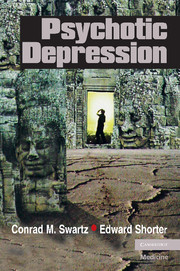Book contents
- Frontmatter
- Contents
- Preface
- Acknowledgments
- Chapter 1 Introduction
- Chapter 2 History of Psychotic Depression
- Chapter 3 Diagnosis in Psychotic Depression
- Chapter 4 Patients' Experience of Illness
- Chapter 5 Treatment in Historical Perspective
- Chapter 6 Treatment: Pitfalls and Pathways
- Chapter 7 Treatment: ECT, Medications, and More
- Chapter 8 Treatment by Type of Psychotic Depression
- Appendix 1 Summary Guide to Psychiatric Concepts
- Appendix 2 Summary Guide to Psychotropic Medication and Treatment
- References
- Index
Chapter 5 - Treatment in Historical Perspective
Published online by Cambridge University Press: 10 September 2009
- Frontmatter
- Contents
- Preface
- Acknowledgments
- Chapter 1 Introduction
- Chapter 2 History of Psychotic Depression
- Chapter 3 Diagnosis in Psychotic Depression
- Chapter 4 Patients' Experience of Illness
- Chapter 5 Treatment in Historical Perspective
- Chapter 6 Treatment: Pitfalls and Pathways
- Chapter 7 Treatment: ECT, Medications, and More
- Chapter 8 Treatment by Type of Psychotic Depression
- Appendix 1 Summary Guide to Psychiatric Concepts
- Appendix 2 Summary Guide to Psychotropic Medication and Treatment
- References
- Index
Summary
An illness that awaits good news
It is october 1879. We are in St. Andrew's Hospital for Mental Diseases in Northampton, England. Consider the treatment options for Miss X, age 31, who had been admitted suffering from melancholia. “On admission the patient was somewhat depressed, and expressed a wish to destroy herself. During the night it was found that she had tied the cord of a window-blind round her neck.” In the weeks ahead, her mood seemed to lighten, yet she persisted in “the delusion that she would ruin the place if detained.” By early December she was deemed well enough to be taken on a skating party on a neighboring meadow, but at the first opportunity she “threw herself into a hole in the ice, from which she was rescued with some difficulty.”
In January, still highly delusional and suicidal, she swallowed a number of straight pins and knitting needles. The next several months of her clinical care focused on giving her laxatives as she slowly, and painfully, passed them in her stool. Finally, she began to recover spontaneously from her depression and was discharged well in September 1880.
What treatments did her medical attendants provide? There were options. “The treatment of the local symptoms at first consisted in the administration from time to time of castor oil,” her physician said. Her abdominal distress from the pins and needles was addressed with “poultices and fomentations.”
- Type
- Chapter
- Information
- Psychotic Depression , pp. 144 - 166Publisher: Cambridge University PressPrint publication year: 2007



